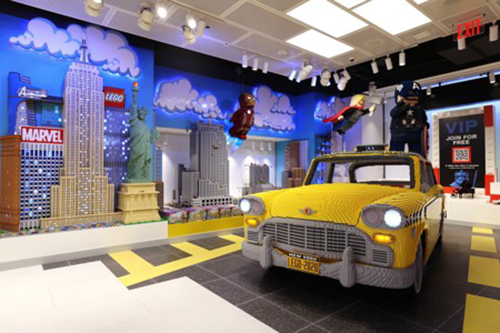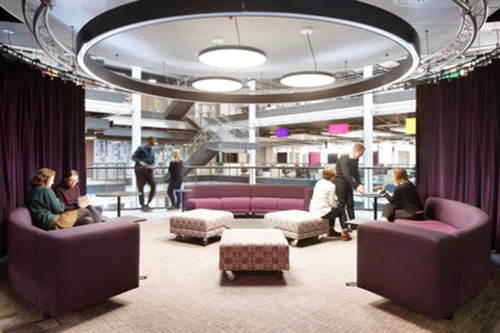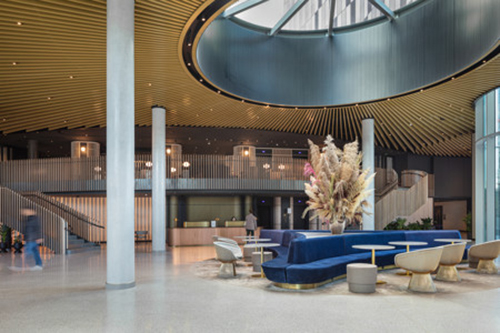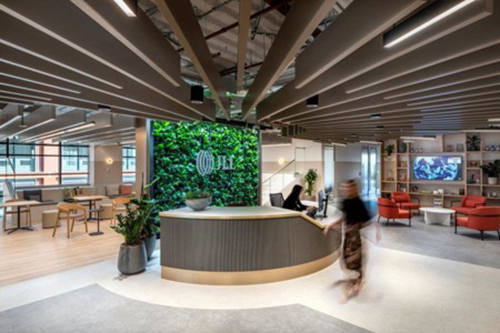Contemporary work styles and strategies
No doubt these are highly unstable times. With the introduction of new work models, such as hybrid or fully remote, organisations need to find strategies to secure a trust-based relationship with employees. The aim is to increase loyalty and job satisfaction. Especially in the high-stress times of economic downturn and increasing energy prices, organisations need to take measures to be innovative and stay competitive. Having a purposeful office where employees can have in-person experiences and great work environments is now more important than ever before. How can such work environments be designed? What can be learned from other sectors such as retail or hospitality design?
Fast-changing environments
The last few years have been dominated by drastic changes in the world, simultaneously affecting the working situation. Where other work revolutions took a couple of years or even decades to evolve, the last four years have all been very different from each other:
- Until 2019: Majority of office workforce have a 5-day work week in the office;
- March 2020: Lockdown and fully remote work where possible;
- 2021: ‘The Great Resignation’, the historically competitive labour market, and emergence of hybrid work styles as the new normal;
- 2023: Return to the office due to economic recession and energy crisis?
Real estate developers, architects and other stakeholders are looking for new strategies when designing or managing office spaces. Those spaces should be attractive for occupants, and thus, futureproof. Fast changes not only demand a high resilience of the workspace but also of the workforce. A new workspace where a diverse, decentralised, and mobile workforce wants to be present and get work done.
Since 2020, several different forms of hybrid work concepts have been established. The idea of where to work from has massively changed the employees’ attitude of coming into the office. The sovereignty over the interpretation ‘how to work’ constantly shifts between employers and employees. It depends on indicators such as market and economic stresses, workforce shortages, and likelihood of employee fluctuation.
Different perceptions between employees and employers
While employers want their staff to come back five days a week, employees have a different take on it. Why is this? Evaluations show that employers and employees have different perceptions of work efficiency, corporate and employer branding, and communication. Additionally, to those main issues, 65% of employees think their office is not ‘adventurous’ enough while employers evaluate the quality of the office more positively.
Obviously, there is a problem; employers want their staff back in the office, while employees don’t seem to see the necessity. And this raises the question whether there is a need for the office.
Benefits of the office

Ethan Bernstein, Professor at Harvard Business School, states that offices are needed – but not for work. According to Bernstein, people go into the office, because they want to be part of the community and socialise with their team colleagues. The office is also the physical place of the company where corporate culture becomes visible and where a sense of ‘belonging’ is more likely to manifest itself.
There are certain synergies that are based on random exchanges between employees. Those benefits include innovating ideas, osmosis learning, networking, and building social skills.
It is essential for successful companies to be able to overcome market shifts and economic stresses by innovating and solution-finding. Especially in an ultra-competitive environment like today, bringing staff back into the office to increase work efficiency is key for business survival.
Another advantage is being able to get different types of work done better. This can either be collaborative work in appropriate spaces or it could be focus work in quiet areas. This is also highly dependent on each individual’s home circumstances. How many of us have a truly ergonomic home office? Is it really possible to concentrate with noisy flatmates or family? The question emerges, how can we make the office attractive, so people want to come back and benefit from the advantages of commercial office space?
Maybe we don’t need to invent everything new but just look into other industries and learn from them.
Retail and hospitality design

Starting from the very beginning, we have to reconsider the connection between the employer and employees of today. Companies are competing for new hires in times of workforce shortage as well as retain the talent they already have. At the same time the employer wants employees to come back and work at the office. Overall, this relationship seems not to be a B2B but rather a B2C relationship, which would turn the employee into a kind of ‘customer’.
If we look at the retail or hospitality industry, we find similarities to this scenario. Competition has always been a big issue. Hotels, restaurants, bars, as well as shops must constantly compete for their customers and guests. But what do they do to attract their audience to choose them over another?
Retail – Experiential design
In the retail sector, there are two levels of competition retailers must face. First, the usual competition among all retailers. That has always been there. The second level is the competition against online shops. The interesting part in this constellation is that the scenario has parallels to the challenges the office is facing with remote work. The retail industry has an extensive database for analysing customer behaviour. This gives them information about customers. What is a super customer experience that makes them want to visit their stores?
The conclusion from their research… first impressions really matter! Look, smell, feel, light, ambience, acoustics, and staff culture. Flagship stores are becoming mandatory for the big brands and their experimental, unconventional, and bold shop designs make headlines, not just for architectural reasons.
Coming into their physical shops triggers many perceptions of the brand’s values and visualised lifestyle. Increasingly, allowing customers to get involved and create personalised items turns the visit in the retail store into an exciting experience. By getting involved with the brand and its products, customer retention is being built.
Hospitality – Feels like home

Let’s go to the hospitality industry. In the first place this seems a little bit erroneous, but if we have a closer look, the difficulties are indeed the same as in the retail sector. Like retail, the hospitality sector is a highly competitive market. The crucial particularity is that the hospitality environment is a temporary replacement for ‘home’.
One hour in a restaurant or two days in a hotel – you want to feel comfort. And if you do enjoy the feeling the environment brings you, you will return to this place.
When designing hospitality interiors, the expectations and preferences of guests are fundamental considerations. Guests appreciate when a hotel incorporates and emphasises parts of the local culture, history, environment, and other aspects of the place in its design. They want to experience a memorable stay, and a variety of landscapes that are uniquely curated with a focus on wellbeing. The best hospitality interiors arouse emotional responses, experiences, and memories. Those design strategies derive from a holistic approach that includes space planning, lighting, acoustics, materials, textures, colours, and carefully selected objects.
Demands on office design that can be answered by elements from hospitality and retail architecture
Ron Martere, business group VP at office furniture maker Steelcase, believes that the office should be the preferred place people come in to get work done. Hospitality and retail architecture can teach us a lot about designing spaces that people want to spend time in. Comfort, excitement, and optimal convenience are transferred into well-thought-through layouts and amenities at top retail and hospitality locations. Companies are currently seeking strategies that will make staff want to come back and benefit from the advantages that derive from working in the corporate office.
Applying design principles from hospitality and retail architecture can facilitate a purposeful, appealing post-pandemic office. Somewhere that is more attractive to work from than anywhere else.
One good example for applying retail design elements is the workplace strategy of tech giant Google. For many years Google has shown how exciting and experiential environments can improve work enthusiasm and make everyone dream of working in one of their unique offices.
The so-called ‘Google Effect’ is describing an office design approach that is based on the brand’s culture and giving the office personality. Similar to retail design, the Google office environment triggers the occupants’ interaction and creativity. Bold colours, extraordinary settings (i.e., yurt shaped meeting rooms), delicious coffee served by in-house barista-bars, calm breakout zones and carefully staged landscapes for different types of tasks are tailored to create an adventurous work experience and facilitate employee satisfaction. This workplace experience is now being adopted as standard in the offices of Ticketmaster (London), Deutsche Bank (New York), Olympic HQ (Lausanne), and multiple other brands.
Hospitality institutions aim to host guests on their property for as long as possible to capture more of their leisure budget. Whereas, company leaders aim to benefit from employees‘ creativity and collaboration in a communal workspace environment. Creating entertaining and immersive places is one way to achieve that target.
Great spaces for people

One of the biggest real estate specialists, JLL, is well aware of what’s needed to get the optimum out of a building’s potential.
In their new London HQ, they turned the reception area into a welcoming and open space that features biophilic elements, and their headquarters into an inviting workplace with various landscapes.
The carefully designed ‘first impression’ not only creates a feeling of being valued but also transfers a sense of belonging and inclusivity as peers already meet up while entering the stylish yet homely office.
Complex preferences and expectations from an increasingly diverse workforce will be more challenging to understand than before. But promoting the sense of belonging, collaboration and wellbeing will reduce employee fluctuation, improve performance, increase job satisfaction, and create higher economic return.
References:
https://chiefexecutive.net/earning-the-commute-what-new-research-says-about-getting-people-back-in-your-office
https://www.archdaily.com/989337/what-is-a-good-interior-design
https://www.mckinsey.com/business-functions/people-and-organizational-performance/our-insights/the-office-of-the-future-a-whole-new-floor-plan
https://quocirca.com/content/will-the-energy-crisis-lure-remote-workers-back-to-the-office/
https://www.rte.ie/news/business/2022/0901/1320013-cipd-on-remote-working-costs/
https://edition.cnn.com/2022/08/15/perspectives/remote-work-economy-recession/index.html
https://www.siteminder.com/de/r/hotel-design-trends/
https://www.rapinteriors.co.uk/inspiration/news/office-design-trends-google-effect-2/
https://www.falstaff.at/nd/hotel-design-weil-der-erste-eindruck-zaehlt/
https://www.greatplacetowork.com/resources/blog/remote-work-productivity-study-finds-surprising-reality-2-year-study
https://www.bbc.com/worklife/article/20210721-whats-the-purpose-of-the-office-and-do-we-still-need-it
https://www.mckinsey.com/business-functions/people-and-organizational-performance/our-insights/the-organization-blog/its-not-about-the-office-its-about-belonging
https://www.socialtables.com/blog/hospitality/hotel-workspaces-coworking/
https://hospitalityinsights.ehl.edu/what-hotel-workspaces-can-offer
https://www.workdesign.com/2021/04/the-rise-of-the-destination-worthy-hospitality-influenced-workplace/
https://www.steelcase.com/research/articles/topics/work-better/earning-the-commute-in-new-york-city
https://www.microsoft.com/en-us/worklab/work-trend-index
https://futureforum.com/pulse-survey/
Hannah Nardini, WKplace, Workplace Scenarios 2030, Clerkenwell Design Week (25.05.2022)

